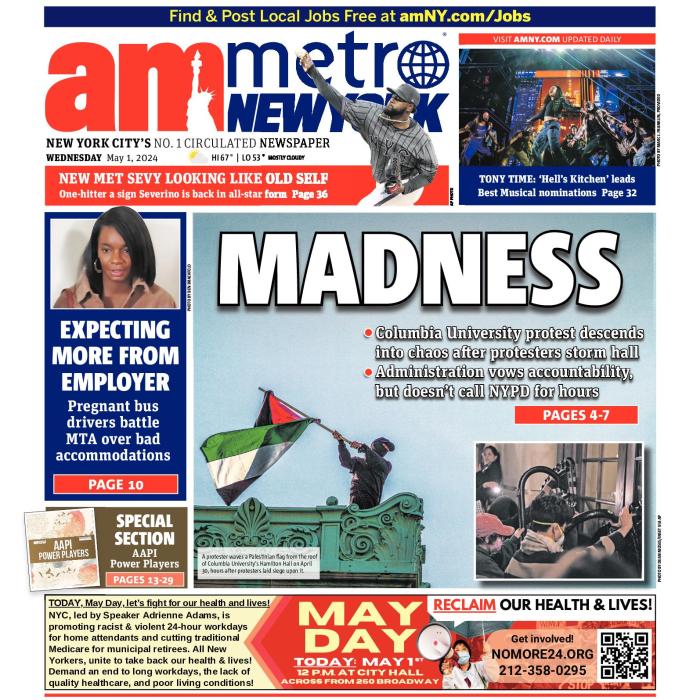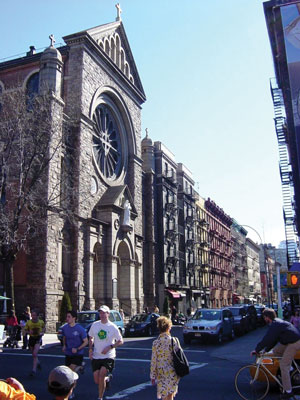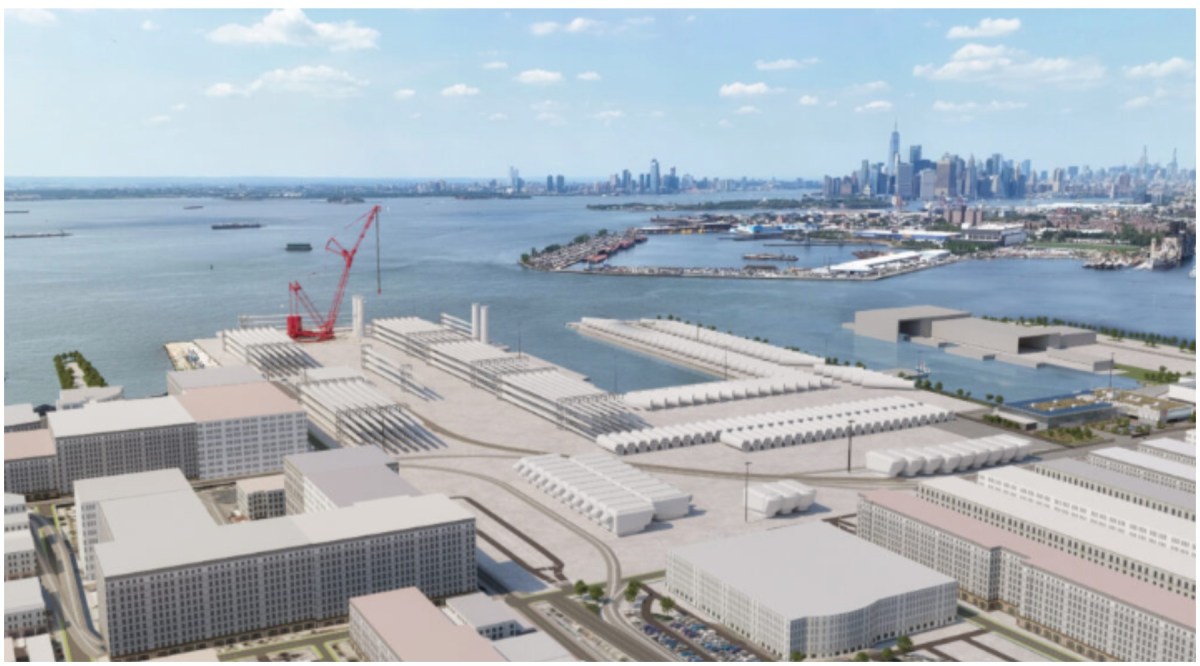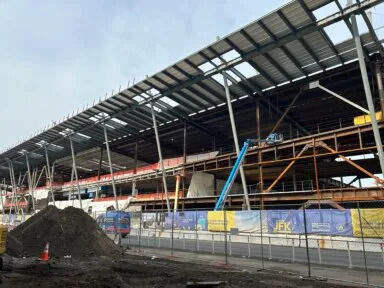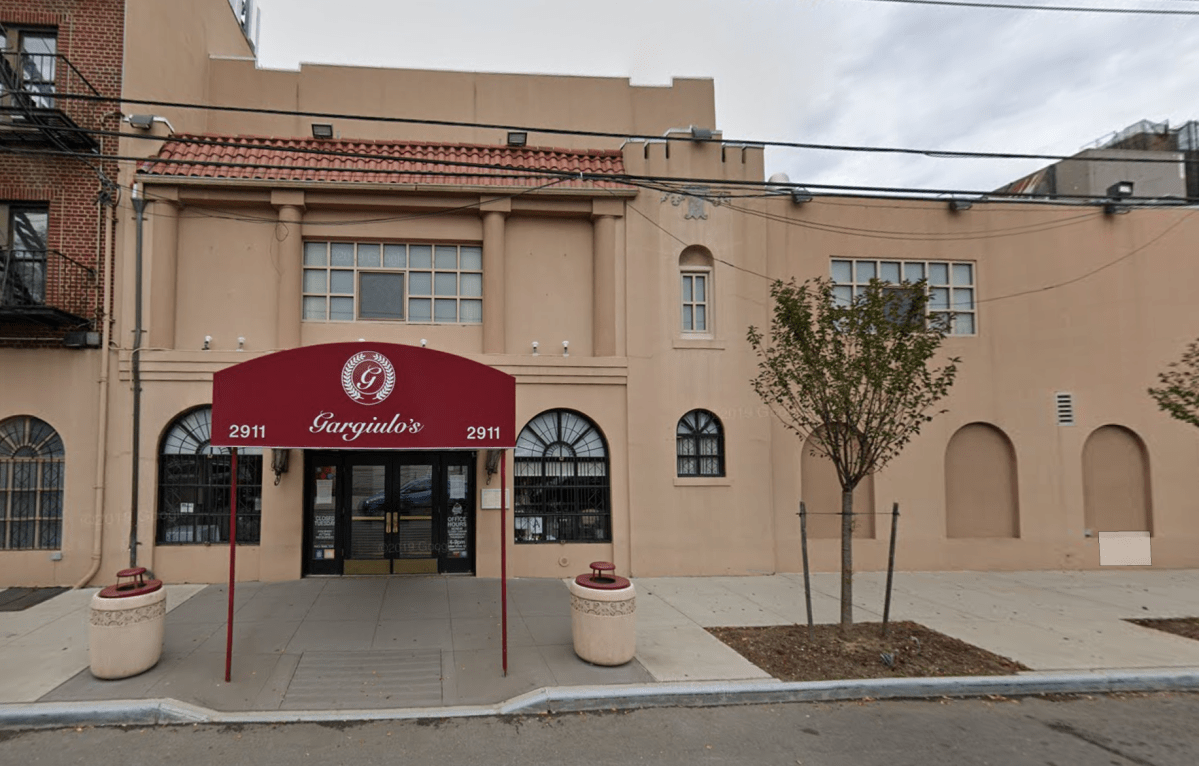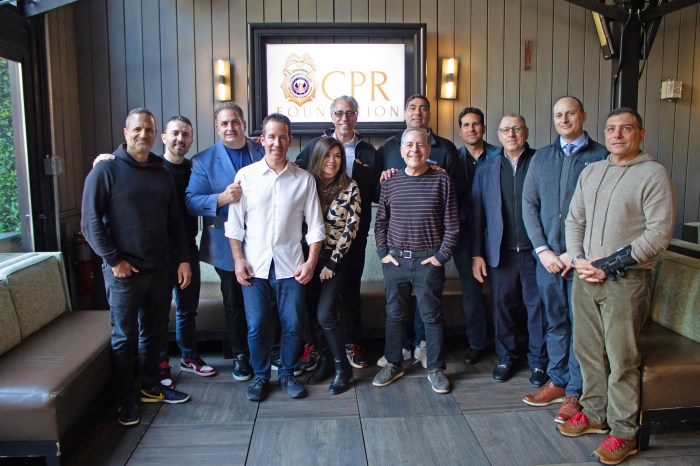PRESERVATION
St. Anthony of Padua Church, the oldest extant Italian-American church in the U.S., and neighboring tenements on Sullivan St., are in the undesignated part of the proposed South Village Historic District.BY ANDREW BERMAN | As is seemingly always the case, our neighborhoods face multiple preservation challenges and myriad threats of overdevelopment. However, a strong response from the community and, in some cases, support from government officials, has allowed some significant progress to be made as well.
First, the good news. In the last year and a half, we have seen the first phase of the Greenwich Village Society for Historic Preservation’s proposed South Village Historic District designated, covering nearly 250 buildings and 12 blocks between Sixth and Seventh Aves., and Houston and W. Fourth Sts. This is the largest expansion of landmark protections in the Village since 1969, and makes the Greenwich Village Historic District far and away the largest in New York City. Countless people, institutions and organizations supported this effort, without whom it would not have been possible.
Also on the landmarking front, earlier this year G.V.S.H.P. and a coalition of community and preservation groups were able to the get the city to expand a proposed East Village / Lower East Side Historic District to include some critical initially overlooked and excluded sites. That proposed district has been calendared, meaning it is officially under consideration, but the city has not yet held a hearing or voted, leaving the area still vulnerable to demolitions.
Additionally, we have been able to stop inappropriate proposed additions to iconic landmarks like the Puck Building, and to reduce the size of proposed additions in historic districts in Gansevoort Market and the West Village. Also finally landmarked was Westbeth, the groundbreaking adaptive reuse of the old Bell Telephone Labs on the Greenwich Village waterfront into affordable artists live/work spaces, which G.V.S.H.P. first proposed for landmark designation in 2004.
On the zoning front, two important rezonings first proposed by G.V.S.H.P. were adopted — one in the Far West Village, and one along the Third and Fourth Aves. corridors. Each faced stiff initial resistance, but eventually with strong local community support, and in the case of the Third / Fourth Aves. corridors the unwavering support of local Councilmember Rosie Mendez, they were finally adopted. In the case of the Far West Village rezoning, it was miraculously adopted in time to pre-empt two developments that had spurred the drive in the first place — a rare accomplishment for a process that usually takes at least a year.
These rezonings limit the size and height of new development, reinforce neighborhood character, and remove incentives for inappropriate commercial (i.e. hotel) or dormitory development in these areas.
There has even been some good news on the N.Y.U. front. As part of its massive 20-year expansion plan, the university proposed to build a 40-story tower — the tallest building ever in the Village — on Bleecker St. Fortunately, G.V.S.H.P. and local residents were able to get the site landmarked in 2008 as part of the designation of the Silver Towers complex, thus requiring Landmarks approval for any such plan. After a furious outcry against the proposal, including by original Silver Towers architect I.M. Pei, N.Y.U. withdrew the proposal.
Of course our neighborhoods still face some daunting preservation and overdevelopment challenges. While the 40-story tower plan is gone, N.Y.U. is still seeking public approvals to allow the addition of 2.5 million square feet of space — the equivalent of the Empire State Building — south of Washington Square Park. To do so would require stripping long-standing neighborhood zoning protections, eliminating open space requirements, giving public park space to N.Y.U. for development, and overturning urban renewal deed restrictions. That public review and approval process will begin in the new year, and G.V.S.H.P. and many others will be fighting it vociferously.
Rudin Management is also seeking zoning changes to allow it to develop the east campus of the former St. Vincent’s Hospital into luxury condos — some in the form of new construction, and some in reused former hospital buildings. In doing so, however, Rudin is asking for an upzoning of the site to allow much of the additional bulk granted to St. Vincent’s in 1979 to accommodate a new hospital to be used by itself — a private developer — for condo development. G.V.S.H.P. is adamantly opposed to such an allowance. That public review and approval process is also expected to begin in the new year.
Other developers are seeking rezonings in our neighborhood as well. Jamestown Properties, the German investment firm and new owner of Chelsea Market, is seeking an upzoning of that block to allow the addition of several hundred thousand square feet of office and hotel space to the complex, in the form of a tower on Ninth Ave. and an addition on 10th Ave., which would cast a shadow on the High Line, the surrounding neighborhood (including the low-rise Meatpacking District directly south) and generate lots of new traffic.
And in Hudson Square, Trinity Realty is seeking an 18-block rezoning from Canal St. to Houston St., and Sixth Ave. to Greenwich St. A rezoning is clearly needed there, since the current zoning allows an enormous density and height of new development (such as the Trump Soho condo hotel). However, the proposed rezoning may help in some areas but not in others. Heights as great as 320 feet and, in one case, 430 feet are proposed for new development, and the addition of as-of-right residential development would no doubt greatly increase development pressure on the adjacent, still-not-landmarked sections of the South Village. G.V.S.H.P. is pushing for changes to this rezoning, which will also likely begin the review and approval process early next year.
G.V.S.H.P. is also seeking to get the city to finally move on promised consideration of the remainder of our proposed South Village Historic District, running roughly from Washington Square to Watts St., Sixth Ave. to LaGuardia Place and just west of West Broadway south of Houston St. Since 2002, we have been lobbying the Landmarks Preservation Commission to designate this area, and with each passing year more historic sites in the neighborhood have been lost. Most recently the Children’s Aid Society agreed to sell its buildings for development. GVSHP called upon the city to keep its 2008 commitment to consider the entire proposed South Village Historic District, but it refused to act. After the public outcry, the new owner promised to preserve and reuse the oldest and most significant of the C.A.S. buildings, but without landmark designation, this promise can be broken and the buildings lost. Both the proposed Hudson Square and N.Y.U. rezonings, each bordering the undesignated sections of the South Village, also threaten to increase development pressure on this fragile historic area.
In the East Village, the good news about the expanded, proposed (but not yet designated) historic districts has been tempered by the city’s unwillingness to protect several other endangered historic sites, and its slow follow-through. In the last several months, we have lost 35 Cooper Square, an intact 1825 Federal-style house with links to the Stuyvesant family and prominent Beat poets; 326 and 328 E. Fourth St., two 1839 Greek Revival row houses with historic connections to the first transatlantic steamship crossing and the East Village’s Hasidic Jewish community and an anarchist utopian arts collective; and 316 E. Third St., an 1834 house between Avenues C and D that was the first structure to ever stand on its site. In each case, G.V.S.H.P. and allied groups brought the threat to these historic sites to the attention of the city, and asked it to save them through landmark designation; each time, the city refused. And even in the East Village Historic District currently under consideration, developers are obtaining demolition and alteration permits while we wait for the city to move ahead with landmark designation.
As always, with every two steps forward, there’s often at least one step back. This coming year promises much more of the same.
Berman is executive director, Greenwich Village Society for Historic Preservation
